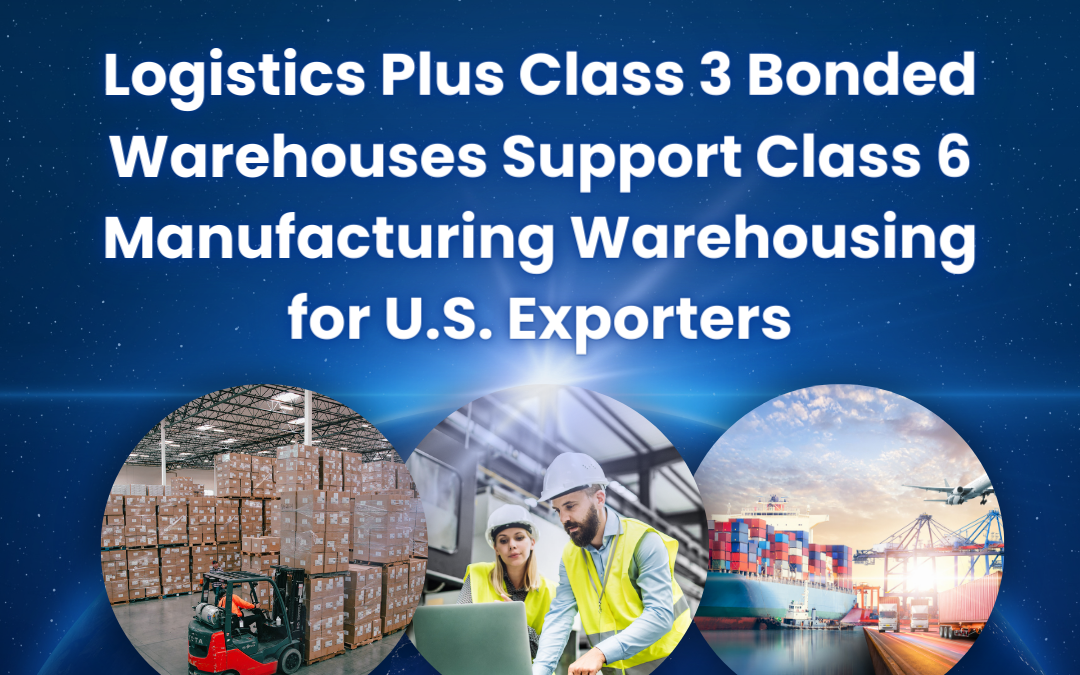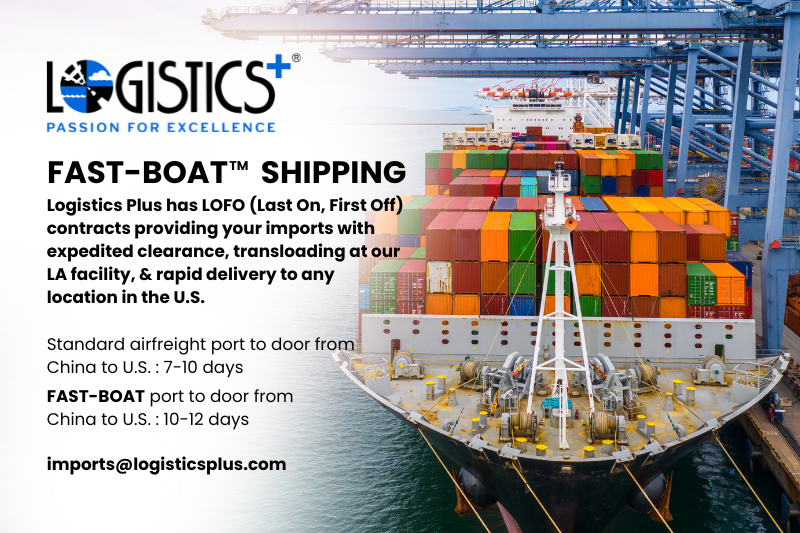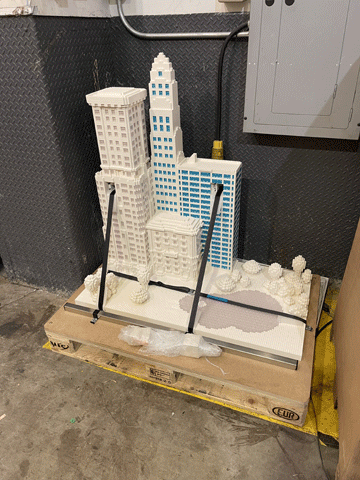
by Scott Frederick | Sep 26, 2024 | News
 As widely reported, if workers at East and Gulf Coast ports strike on Oct. 1, manufacturing supply chains throughout the U.S. will be severely impacted. The National Association of Manufacturers (NAM) published a very insightful, interactive map of the ports that will be potentially impacted and some interesting import/export facts for many of them. Check it out here:
As widely reported, if workers at East and Gulf Coast ports strike on Oct. 1, manufacturing supply chains throughout the U.S. will be severely impacted. The National Association of Manufacturers (NAM) published a very insightful, interactive map of the ports that will be potentially impacted and some interesting import/export facts for many of them. Check it out here:
https://nam.org/mapping-the-impact-of-a-port-strike-32072
According to NAM, here some key data points:
- More than 68% of all containerized exports and more than 56% of containerized imports flow through East and Gulf Coast ports, representing an average daily trade value of more than $2.1 billion.
- They handle more than 91% of containerized imports and 69% of containerized exports of pharmaceutical products.
- They also process more than 76% of containerized vehicle exports and more than 54% of containerized vehicle imports.
- For air and spacecraft, more than 77% of containerized exports and more than 51% of containerized imports go through these ports.
To prepare for a potential labor strike by the International Longshoremen’s Association (ILA) on the Gulf Coast and East Coast, importers and exporters can consider several contingency plans:
- Reroute Cargo: Explore alternative shipping routes. Ports on the U.S. West Coast, Canada, and Mexico can serve as viable alternatives. For example, cargo can be diverted to ports like Los Angeles, Long Beach, or Vancouver.
- Multi-Coastal Transportation Network: Establish a network that includes multiple coastal gateways. This can involve setting up transload operations or smaller volume operations that can be scaled up if needed.
- Extended Gate Hours: Take advantage of ports extending their gate hours to process as much cargo as possible before any potential strike. Ports like New York, New Jersey, and Savannah are offering extended weekend hours.
- Airfreight Options: For time-sensitive shipments, consider using airfreight, although it comes at a higher cost and with capacity concerns.
- Communication with Ports and Carriers: Stay in close contact with ports and carriers for the latest updates and advisories. Many ports are sharing daily updates about their contingency plans.
- Inventory Management: Increase inventory levels of critical goods to buffer against potential delays. This is especially important for industries relying on just-in-time inventory models.
- Legal and Contractual Preparations: Review contracts and legal agreements to understand the implications of delays and disruptions. Ensure there are clauses that cover force majeure events like strikes.
Working with an experienced capable freight forwarder, like Logistics Plus, importers and exporters can implement the above strategies and better navigate the potential disruptions caused by a labor strike.


by logisticsplus | Feb 21, 2024 | News


Does your U.S. business import goods that will ultimately be exported to customers outside the United States? If yes, your business might be using a class 6 warehouse, also known as a “manufacturing warehouse” or “bonded manufacturing warehouse.” A class 6 manufacturing warehouse is a special type of bonded facility authorized by customs authorities that allows for the in-bond manufacturing or processing of goods using imported materials or materials subject to internal revenue taxes. These manufactured goods can then be exported or, in some cases, sold domestically under specific regulations.
The import/export benefits of using a class 6 manufacturing warehouse include:
- Reduced duty payments: Importers can defer or even avoid paying import duties on materials used in manufacturing until the finished product is exported. This can significantly improve cash flow and reduce upfront costs.
- Increased flexibility: Importers can adapt their products to different markets or customer specifications by modifying them within the warehouse.
- Improved logistics: By combining import and manufacturing in one location, importers can streamline their supply chain and simplify logistics.
- Enhanced competitiveness: By manufacturing goods closer to the target market, exporters can reduce transportation costs and offer more competitive prices.
- Increased control over quality: Exporters can ensure product quality by directly overseeing the manufacturing process within the warehouse.
- Access to new markets: Manufacturing in a bonded warehouse can help exporters comply with specific import regulations in certain countries, opening up new market opportunities.
It’s important to note that:
- Class 6 manufacturing warehouses have specific regulations and requirements established by customs authorities. Obtaining and maintaining a license can be complex (if needed, Logistics Plus can help).
- Not all types of goods are eligible for manufacturing in a class 6 warehouse (Logistics Plus can help you determine whether your goods are eligible).
- Recordkeeping and security protocols are stringent within these facilities (Again, Logistics Plus can help with some or all of this).
Overall, class 6 warehouses can offer significant benefits to importers and exporters seeking to optimize their supply chains, reduce costs, and access new markets. They also work well in tandem with class 3 warehouses.
Logistics Plus currently has a class 3 bonded warehouse in Strongsville, OH (Cleveland), with additional class 3 manufacturing warehouses available soon in Chicago, IL; Dallas, TX; Memphis, TN; and Phoenix, AZ. Logistics Plus can help import goods and store them at one of our class 3 bonded warehouses until they are ready to go to your class 6 warehouse for final manufacturing and export. If you currently don’t have a class 6 warehouse, Logistics Plus can help find or staff one for you.
Check out this U.S. CBP online guide to the various classes of bonded warehouses.
Contact Us to learn more about Logistics Plus warehouse solutions.


by logisticsplus | Jan 30, 2024 | News

Logistics Plus Secures Customs Bonding for New Strongsville, OH Warehouse
Additional Customs bonding is expected soon at many of its other warehouses across the U.S.
 ERIE, PA (January 30, 2024) – Logistics Plus, Inc. (LP), a leading worldwide provider of transportation, logistics, and supply chain solutions, has secured Customs bonding from the U.S. Customs & Border Protection (CBP) at its new warehouse located south of Cleveland, OH. The 165 thousand square foot warehouse located in Strongsville, OH, was officially opened late last year. Additional Customs bonds are in progress for Logistics Plus warehouses in Phoenix, AZ, Chicago, IL, Memphis, TN, and Dallas, TX.
ERIE, PA (January 30, 2024) – Logistics Plus, Inc. (LP), a leading worldwide provider of transportation, logistics, and supply chain solutions, has secured Customs bonding from the U.S. Customs & Border Protection (CBP) at its new warehouse located south of Cleveland, OH. The 165 thousand square foot warehouse located in Strongsville, OH, was officially opened late last year. Additional Customs bonds are in progress for Logistics Plus warehouses in Phoenix, AZ, Chicago, IL, Memphis, TN, and Dallas, TX.
Customs bonded warehouses are a type of warehouse where goods can be stored and processed before paying taxes. The primary users of bonded warehouses are importers and exporters who need to store goods temporarily before shipping them to their final destination.
Benefits of using a Customs bonded warehouse include:
- Avoiding expensive terminal fees associated with withhold release orders (WRO) holds for shipments reviewed for the Uyghur Forced Labor Prevention Act (UFLPA).
- Allows importers to delay paying duties on their imported goods.
- If the goods are destroyed under CBP supervision, no duty is payable.
- Goods stored in a bonded warehouse are exempt from customs inspections, saving the importer time and money.
- Offers increased security for goods because Customs officials monitor them.
- Under CBP supervision, goods can be manipulated by cleaning, sorting, repacking, or otherwise changing their condition by processes that do not amount to manufacturing.
- Goods may be exported without the payment of duty, or they may be withdrawn for consumption upon payment of duty at the rate applicable to the goods in their manipulated condition at the time of withdrawal.
- Goods may remain in the bonded warehouse for up to five years from the date of importation, allowing the importer additional time to handle the paperwork and legal formalities.
 “Many bonded warehouses across the U.S. are private, meaning they are dedicated to only one importer,” said Gretchen Blough, Customs Brokerage Manager for Logistics Plus. “This means that bonded warehouse space is very scarce and at a premium when it can be found. We decided to create our own bonded warehouse space with our existing public warehouses so our customers have better options than what is currently available in the warehousing market.”
“Many bonded warehouses across the U.S. are private, meaning they are dedicated to only one importer,” said Gretchen Blough, Customs Brokerage Manager for Logistics Plus. “This means that bonded warehouse space is very scarce and at a premium when it can be found. We decided to create our own bonded warehouse space with our existing public warehouses so our customers have better options than what is currently available in the warehousing market.”
About Logistics Plus, Inc.
Logistics Plus, Inc. (LP) is a 21st-century logistics company and a leading worldwide provider of transportation, warehousing, fulfillment, global logistics, business intelligence, technology, and supply chain solutions. LP works in the background to help businesses manage their supply chains in an ever-changing world. Founded in 1996, today LP has annual global sales of over $500M with more than 1,000 employees located in 50+ countries worldwide. LP is recognized as one of the fastest-growing privately-owned logistics companies, a top 3PL provider, a top 100 logistics company, a top freight brokerage and warehousing provider, and a great place to work. With a Passion For Excellence™, its employees put the PLUS in LOGISTICS by doing the big things properly, plus the countless little things that together ensure complete customer satisfaction and success.




by logisticsplus | Nov 7, 2023 | News
Logistics Plus is pleased to offer a Fast-Boat shipping service as a viable air freight alternative for importers needing to get their critical shipments from China. By maintaining LOFO (last on, first off) contracts with major ocean lines, Logistics Plus can provide importers with expedited customs clearance, transloading at our Los Angeles facility, and final delivery to any location in the United States.
Please note that our Fast-Boat shipping service is only available from Shanghai and Ningbo to the port of Los Angeles. Traditionally, this service is for full containers only. However, if you have LCL (less-than-container load) needs, our imports team can help coordinate consolidations out of Shanghai/Ningbo for the same service.


Now more than ever, our Fast-Boat service can assist customers in getting their containers to the East Coast promptly by avoiding the ongoing bottlenecks at the Panama Canal.
Importers interested in learning more about our Fast-Boat shipping solutions are encouraged to email imports@logisticsplus.com.

by logisticsplus | Jul 8, 2022 | News
 Kudos to Kalynne Ziacik, a Logistics Plus Air Import Specialist, for helping a major, global retailer with a critical Lego® window display delivery for their flagship NY store. The shipment was delivered intact ahead of their deadline. It was another LP team effort, but you could also say that Kalynne did most of the ‘leg-o-work’ on this project ?.
Kudos to Kalynne Ziacik, a Logistics Plus Air Import Specialist, for helping a major, global retailer with a critical Lego® window display delivery for their flagship NY store. The shipment was delivered intact ahead of their deadline. It was another LP team effort, but you could also say that Kalynne did most of the ‘leg-o-work’ on this project ?.
TEAMWORK = DREAMWORK! ♥



 As widely reported, if workers at East and Gulf Coast ports strike on Oct. 1, manufacturing supply chains throughout the U.S. will be severely impacted. The National Association of Manufacturers (NAM) published a very insightful, interactive map of the ports that will be potentially impacted and some interesting import/export facts for many of them. Check it out here:
As widely reported, if workers at East and Gulf Coast ports strike on Oct. 1, manufacturing supply chains throughout the U.S. will be severely impacted. The National Association of Manufacturers (NAM) published a very insightful, interactive map of the ports that will be potentially impacted and some interesting import/export facts for many of them. Check it out here:






 ERIE, PA (January 30, 2024) – Logistics Plus, Inc. (LP), a leading worldwide provider of transportation, logistics, and supply chain solutions, has secured Customs bonding from the U.S. Customs & Border Protection (
ERIE, PA (January 30, 2024) – Logistics Plus, Inc. (LP), a leading worldwide provider of transportation, logistics, and supply chain solutions, has secured Customs bonding from the U.S. Customs & Border Protection (




